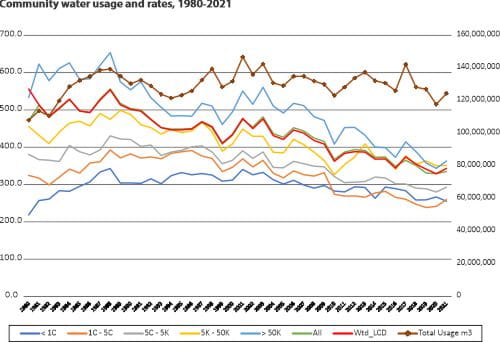
Why we measure this
With a growing population, there is increasing pressure on Saskatchewan's water resources. Economic growth, climate change and extreme weather events also add to the strain, making this measure even more important.
Conserving our water makes economic sense. If water conservation can keep demand within the capacity of existing systems, expensive investments in new reservoirs and pipelines can be reduced or avoided. Pumping and treating water also consume energy. Reducing the use of treated water cuts energy consumption and greenhouse gas emissions.
What is happening

Saskatchewan's water usage continues to trend downward; however, in 2021 there was a slight increase over the previous couple of years, with residents using an average of 343 litres per capita per day (versus 329 litres per capita per day in 2020). Since some communities have not reported (400 communities reported in 2017 and 336 in 2021), the Water Security Agency cannot determine an absolute difference in overall usage.
Over the last 30 years, total community water consumption has generally been stable, but with a general decrease in usage rates (litres per day). The decline in usage is likely the result of technological investments (e.g. new water mains and high efficiency plumbing fixtures) and behavioural influences on water use.
Usage rates in smaller communities are more variable, with the smallest communities trending towards increased usage. This is likely due to improvement in the security of water supplies, or the transition to other water treatment technologies with higher raw water requirements (e.g. reverse osmosis). Small communities are also more likely to see increases in per capita use as a result of declining populations. That is, the water used for municipal services and commercial operations may not decline, but will be spread over a smaller population base.

What we are doing
The Water Security Agency continues to promote responsible water use through public education, partnerships and a variety of programs. Water rates set by waterworks owners that recognize the true and full cost of system design, construction, operation and maintenance also help promote water conservation.



